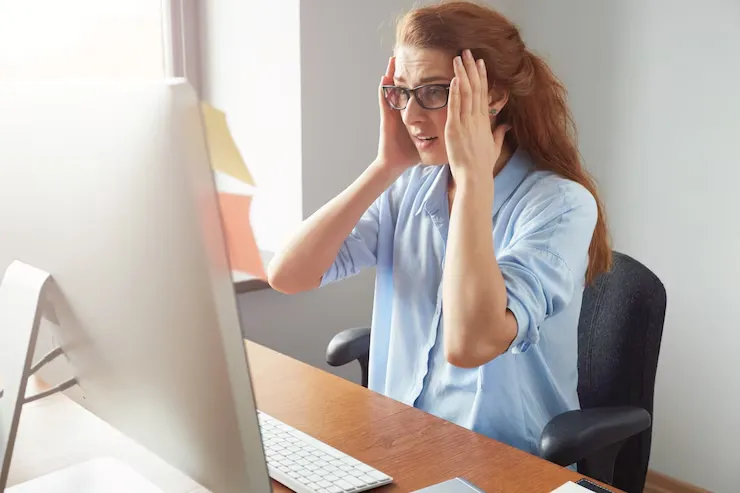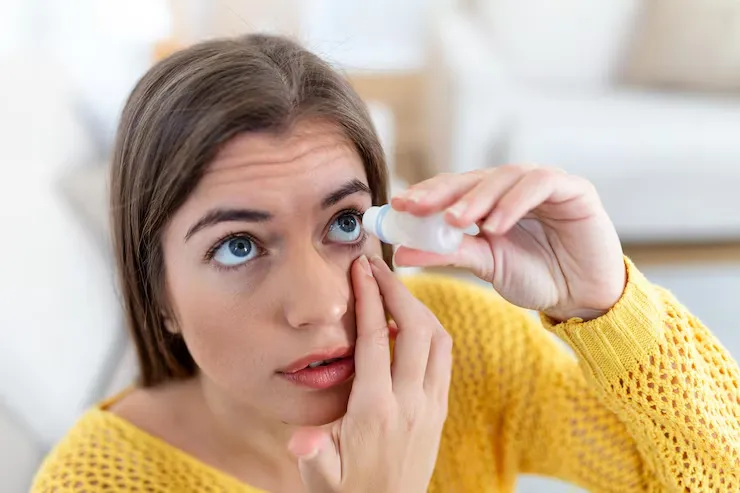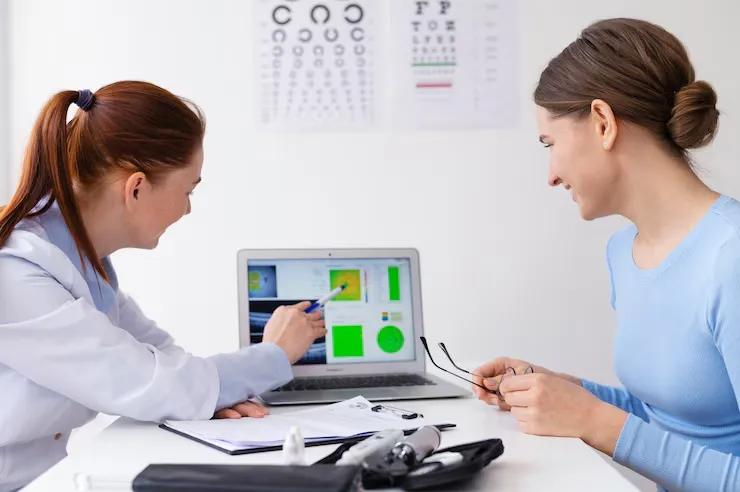Eye Health
Understanding Digital Eye Strain vs CVS
FSDAVCFEBFEVSDDVFSD
FSDAVCFEBFEVSDDVFSD
FSDAVCFEBFEVSDDVFSD
What Makes Them Different?
Digital eye strain and computer vision syndrome (CVS) are often used interchangeably, but they aren't exactly the same. Both terms describe discomfort related to prolonged screen use, yet the scope and severity of each differ. Digital eye strain is typically a temporary condition caused by overexposure to digital screens. Symptoms include blurred vision, eye fatigue, and dryness, which usually subside after resting the eyes.
CVS, on the other hand, encompasses a broader set of visual and physical symptoms brought on by extended computer or digital device usage. It may include neck pain, headaches, and longer-lasting visual disturbances. Understanding the distinctions between these conditions can help individuals seek the appropriate treatment and make informed decisions about eye care habits.
Digital eye strain and computer vision syndrome (CVS) are often used interchangeably, but they aren't exactly the same. Both terms describe discomfort related to prolonged screen use, yet the scope and severity of each differ. Digital eye strain is typically a temporary condition caused by overexposure to digital screens. Symptoms include blurred vision, eye fatigue, and dryness, which usually subside after resting the eyes.

CVS, on the other hand, encompasses a broader set of visual and physical symptoms brought on by extended computer or digital device usage. It may include neck pain, headaches, and longer-lasting visual disturbances. Understanding the distinctions between these conditions can help individuals seek the appropriate treatment and make informed decisions about eye care habits.

Key Causes and Risk Factors
Extended screen time, improper posture, and poor lighting all contribute to both conditions. However, digital eye strain is more likely to occur from brief bursts of screen use throughout the day—such as smartphone or tablet browsing—whereas CVS often results from continuous screen use over several hours, particularly in work or study environments.
One significant contributing factor is blue light exposure, which can suppress melatonin production and disrupt sleep. For patients who work in front of screens all day, symptoms like shoulder tension, dry eyes, and trouble refocusing are more aligned with CVS.
At Kleinwood Vision, we evaluate how your daily habits may contribute to your symptoms and offer tailored recommendations, including the use of blue light blocking lenses and screen time routines. Understanding your screen usage pattern is crucial for preventing long-term discomfort and reducing the risk of worsening symptoms over time. Another risk factor is uncorrected vision issues. People with astigmatism or farsightedness may unknowingly strain their eyes more during screen use. Addressing these problems with appropriate vision correction can significantly improve screen comfort and reduce strain.
Recognizing the Symptoms

Digital eye strain typically presents with symptoms such as mild headaches, watery eyes, and intermittent blurry vision. These issues usually arise after prolonged screen use, typically around two hours, and often improve with rest or taking breaks from the screen. While these symptoms are generally temporary, they can be bothersome and affect productivity.
On the other hand, Computer Vision Syndrome (CVS) involves more persistent symptoms, including visual fatigue, muscle tension in the neck and shoulders, and consistent double vision. Unlike digital eye strain, CVS symptoms do not easily improve with short breaks and can significantly impact daily activities.

If you're frequently experiencing these issues, it's important to consider the possibility of CVS and seek appropriate measures to manage the condition. Regular eye exams, proper ergonomics, and reducing screen time can help alleviate the symptoms associated with digital eye strain and CVS.
Addressing digital eye strain and Computer Vision Syndrome (CVS) begins with improving screen habits. Simple adjustments, such as regulating screen brightness, using anti-glare filters, and following the 20-20-20 rule—looking at an object 20 feet away for 20 seconds every 20 minutes—can significantly reduce strain. These strategies are especially effective for alleviating the temporary symptoms of digital eye strain and can be easily incorporated into daily routines to maintain visual comfort.
For individuals experiencing chronic CVS symptoms, comprehensive eye exams are essential. At Kleinwood Vision, we go beyond checking prescriptions to evaluate how your eyes function during screen-based tasks. Depending on the findings, we may recommend solutions like blue light-blocking glasses, ergonomic adjustments, or advanced treatments such as NeuroLens for digital fatigue relief. These tailored interventions help address the multifactorial nature of CVS by identifying and treating its root causes, leading to more effective and lasting outcomes.
Practical Tips for Relief
Reducing symptoms of digital eye strain starts with simple ergonomic adjustments. Position your screen 20–28 inches from your eyes, with the top of the monitor at or just below eye level. This setup encourages a natural gaze and helps alleviate neck and shoulder tension. Maintaining an upright posture and using a chair with proper back support can also contribute to better comfort during prolonged screen use.
Additionally, minimizing glare by reducing overhead lighting can significantly enhance visual comfort. If you wear glasses, consider lenses with anti-reflective coatings or those specifically designed for screen use to reduce eye strain. These measures are particularly effective for individuals who spend several hours on screens daily, whether for work or school, offering a straightforward way to maintain both eye and overall health.
Treatment Strategies That Work
Relieving digital eye strain and Computer Vision Syndrome (CVS) requires a tailored approach, as individuals experience screen-related stress differently. For occasional eye fatigue, simple solutions like lubricating eye drops and regular visual breaks may suffice. However, chronic or recurring issues often necessitate professional intervention to address underlying causes effectively.
At Kleinwood Vision, we offer comprehensive digital eye exams that assess screen usage, eye alignment, and focusing abilities. Based on the findings, we may recommend advanced solutions such as specialty contact lenses or NeuroLens therapy, designed to alleviate digital fatigue and improve overall eye comfort.
Relieving digital eye strain and Computer Vision Syndrome (CVS) requires a tailored approach, as individuals experience screen-related stress differently. For occasional eye fatigue, simple solutions like lubricating eye drops and regular visual breaks may suffice. However, chronic or recurring issues often necessitate professional intervention to address underlying causes effectively.
At Kleinwood Vision, we offer comprehensive digital eye exams that assess screen usage, eye alignment, and focusing abilities. Based on the findings, we may recommend advanced solutions such as specialty contact lenses or NeuroLens therapy, designed to alleviate digital fatigue and improve overall eye comfort.


Our team also emphasizes patient education on screen-related vision care, including blue light protection, ergonomic adjustments, and long-term strategies to maintain eye health and comfort during screen use.
When to Seek Professional Help
If you’re experiencing persistent symptoms like frequent headaches, blurry vision, or eye tension despite regular breaks and environmental adjustments, it’s time to consult an optometrist. These symptoms may point to a deeper issue than temporary digital strain, such as Computer Vision Syndrome (CVS). Early detection is crucial for addressing underlying problems before they worsen, ensuring long-term eye health and comfort.
A professional assessment provides clarity, identifying whether your symptoms are due to simple digital fatigue or more complex concerns. At Kleinwood Vision, we take a personalized approach to screen-related eye care. Our evaluations consider your screen habits, focusing abilities, and eye alignment. This comprehensive understanding allows us to craft treatment plans tailored to your unique needs, offering solutions that address the root causes of discomfort.
Ignoring these symptoms can lead to chronic issues that impact your productivity and overall well-being. Treatments may involve something as straightforward as ergonomic changes and blue light protection or more advanced options like NeuroLens therapy for digital fatigue relief. Addressing these challenges early prevents escalation and ensures that your eyes stay healthy and comfortable, even with prolonged screen use.
Regular eye checkups are a cornerstone of proactive vision care. Whether for work, school, or leisure, our lives increasingly revolve around screens. By prioritizing professional assessments and personalized solutions, you can maintain not just your vision but your quality of life. Taking steps today ensures that you can navigate your digital environment comfortably, keeping your eyes healthy for years to come. Comprehensive care from experts like those at Kleinwood Vision equips you with tools and strategies to minimize strain and enjoy clear, relaxed vision in every aspect of your day.
Long-Term Eye Health Tips
Practicing preventive care is vital for maintaining visual comfort and overall eye health. Simple measures such as updating your prescription regularly, improving workspace ergonomics, and managing screen time can significantly reduce eye strain and discomfort. These proactive steps create a healthier environment for your eyes and enhance productivity.

Practicing preventive care is vital for maintaining visual comfort and overall eye health. Simple measures such as updating your prescription regularly, improving workspace ergonomics, and managing screen time can significantly reduce eye strain and discomfort. These proactive steps create a healthier environment for your eyes and enhance productivity.
Scheduling annual comprehensive eye exams is another essential component of preventive care, especially if you experience frequent eye strain or notice changes in your vision. These checkups can detect early signs of Computer Vision Syndrome (CVS) or other eye conditions, allowing for timely intervention to prevent further complications.
Scheduling annual comprehensive eye exams
is another essential component of preventive care, especially if you experience frequent eye strain or notice changes in your vision. These checkups can detect early signs of Computer Vision Syndrome (CVS) or other eye conditions, allowing for timely intervention to prevent further complications.
Additionally, discussing your screen habits with your eye doctor is crucial. Sharing specific details about your daily screen use helps professionals recommend tailored solutions, such as advanced lens designs or screen-specific treatments. Personalized care ensures that your eyes remain comfortable and healthy in today’s digitally demanding world.
Final Thoughts on Eye Strain
Digital eye strain and computer vision syndrome (CVS) are increasingly common due to our growing reliance on digital screens. While both conditions stem from extended screen use, they differ in severity and underlying causes. Digital eye strain often results from temporary discomfort due to prolonged screen time, whereas CVS involves more persistent symptoms such as visual fatigue, headaches, and neck tension. Recognizing these differences is vital for accurate diagnosis and effective management.
Taking proactive steps to address these issues can significantly enhance daily comfort. Simple measures like adjusting screen brightness, improving workspace ergonomics, and following the 20-20-20 rule—taking a 20-second break to look at something 20 feet away every 20 minutes—can alleviate symptoms. Consulting an experienced optometrist is equally important for personalized care. With tailored solutions such as specialized lenses or advanced therapies, you can reduce screen-related discomfort and maintain long-term eye health in a digital age.

Contact Info
Hours of Operation
Mon - Fri | 9:00 AM - 5:00 PM
Sat - Sun | Closed
Holiday Hours: We are closed for the following holidays: New Years Day, Memorial Day, Independence Day, Labor Day, Thanksgiving Day, Christmas Day
© 2025 Kleinwood Vision. All rights Reserved.


